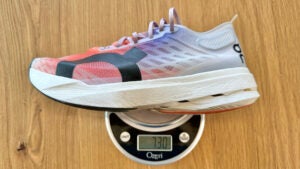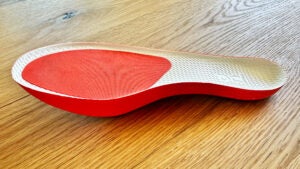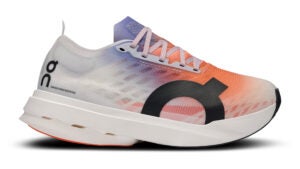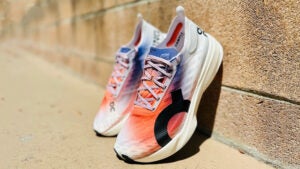New perk! Get after it with local recommendations just for you. Discover nearby events, routes out your door, and hidden gems when you sign up for the Local Running Drop.
At this stage of the carbon-plated racing shoe era, the fundamentals of creating a high-performing supershoe are well understood. It’s a simple recipe: embed a curved carbon fiber plate between a thick stack of responsive foam, top it with a racey minimal upper, and you likely have a solid supershoe.
What distinguishes the truly exceptional supershoes from the average ones are subtle details like fine-tuned plates and midsole geometry, innovative foaming processes, and an obsession with weight reduction. On’s latest carbon fiber plated marathon supershoe, the Cloudboom Strike, is a prime example of how outside-the-box thinking and attention to detail can create an exceptional product that evolves the supershoe formula.

Innovative Design of the On Cloudboom Strike
When designing the Cloudboom Strike, Jaime García Romo, Athletes Innovation Product Manager at On Running, explains, “We focused on trying to remove all non-performing materials and optimizing as much as possible in the performing ones.”
Toward this end, Romo and his team took aim at the strobel and the sockliner. Typically, moving from the ground up, a supershoe consists of an outsole, midsole with an embedded plate, strobel, and sockliner (also known as the insole). The strobel is a thin layer between the sockliner and midsole. It’s nothing more than a 1.5 to 2-millimeter layer of fabric or foam on which the upper is sewn. The sockliner is a thin layer of (usually) low-grade foam that sits above the strobel and provides step-in cushioning. On’s engineers looked for a way to remove the underperforming strobel and sockliner from the stack.
This type of reductive design is more commonly found in the basketball shoe industry, but similar concepts have recently started appearing in running shoes. For example, Speedland shoes feature a removable midsole and carbon fiber plate, and the yet-to-be-released Tracksmith Elliot Racer and NNormal Kboix will also include a removable midsole layer. These all replace the standard sockliner with a high-performing layer of midsole foam, like the Cloudboom Strike, but it also eliminates the Strobel, attaching the upper directly to the carbon fiber plate.

Now, instead of the foot landing on a low-grade foam insole and a stiff strobel, it sinks into a layer of On’s highest energy-returning Helium Hyperfoam material directly underfoot. This removable insert, that On calls the “bounceboard,” is much thicker than your typical sockliner, especially where the plate curves away in the forefoot.
This replacement results in an additional 3 to 4 millimeters of foam underfoot. While the 39.5-millimeter stack height is similar to other supershoes, more of that stack is made up of top-quality foam with the Cloudboom Strike. More foam underfoot translates to increased cushioning, which On says helps save your legs. “Fresh legs are fast legs,” Romo says, a mantra that he says informed the design of the shoe.
To further enhance performance, Romo and his team obsessed over the geometry of the shoe, focusing on optimizing the rocker, midsole cutouts and Cloudtech cavities. While the Cloudtech cavities in the midsole along the heel may look small, Romo explains that they were carefully scrutinized both in the lab and on athletes’ feet to create the smoothest transition possible.

On Cloudboom Strike
Weight: 7.4 oz (men’s 9); 5.9 oz (women’s 7.5)
Stack Heights: 39.5 mm (heel); 35.5 mm (forefoot)
Heel-to-toe Drop: 4 mm
At A Glance
Pros
- Bouncy, well-cushioned foam
- Optimized for a wide range of paces
- Comfortable, secure-fitting upper
- High-quality laces
Cons
- Somewhat unstable, especially when heel-striking
- Laces too long
- Noisy
On Cloudboom Strike First Impressions
Right from the start, I could tell the Cloudboom Strike is a very different shoe than the Cloudboom Echo 3, On’s previous carbon-fiber marathon racer. Besides being slightly lighter, the foam feels considerably softer, and there’s more of it. If you found the Cloudboom Echo stiff and lacking cushioning, you’re going to like these. Had Romo not told me this was a replacement for the Echo, I would have thought it was a completely new shoe line.
Once they arrived, I was eager to get them out on the road, so I took them for a seven-mile spin at my easy-to-moderate pace. Immediately upon putting them on, I could tell this was my type of supershoe—uber-soft underfoot with a good amount of trampoline-like bounce. The midsole’s density felt a lot like a softer version Adidas’ Lightstrike Pro.
What struck me was that they felt much taller than most legal supershoes of similar height, bound by a World Athletics regulation that competition shoes may not exceed 40 millimeters under the heel. The Cloudboom Strike’s ride reminded me a lot of running in the 50-millimeter, over-the-limit stack height Adidas Prime X Strung, both in terms of height and the level of cushioning. Replacing the Strobel and insole with the bounceboard makes it feel like considerably more foam underfoot. The downside was that the Cloudboom Strike also felt quite tipsy—I would rate it one of the more unstable supershoes I’ve tested.
My next test run was a 9-mile run with 25 minutes of broken threshold pace—a much more suitable test of the Cloudboom Strike capabilities. This is where the shoe really started to shine. Most supershoes fall on a spectrum of feeling either highly cushioned—saving your legs from pounding—or highly bouncy, helping each footstrike pop back up. At threshold pace, the Cloudboom Strike felt balanced between the two, leaning a bit more towards the cushioned side.

When testing, I often purposely alter my stride and footstrike to see how the shoe responds to varying gaits. The Cloudboom Strike felt the most natural at a midfoot to rearfoot strike pattern. I found it difficult to really get up and stay on my toes. This makes sense, given it’s designed for marathon racing, where most runners will adopt a midfoot or heel strike over the course of the race
However, I was surprised and pleased by how smooth and competent the Cloudboom Strike felt, even when doing 6 x 100-meter strides at mile race pace. Although designed for marathon pace, the shoe can easily handle much faster speeds. This versatility makes it an excellent choice to double as a workout shoe.
From an aesthetics standpoint, I found the Cloudboom Strike attractive and well-constructed. The upper is a thin, abrasion-resistant, semi-transparent mesh with a reinforced cage system laminated on the inside for added support and structure.
Both the fit and lockdown were outstanding. Tightening the laces created a smooth, even pressure throughout the upper, securely engulfing my feet like a tightly wrapped burrito. I found that the reinforced feel of the upper helped counteract some of the instability issues caused by the shoe’s height.
On Cloudboom Strike: Who Is It For?
Most supershoes seem to be optimized for specific paces. During my testing, I found the Cloudboom Echo had a much larger sweet spot than most and performed well across a wide range of paces. Despite this versatility, the shoe has limitations, including a tall, narrow stance that feels tipsy at slower paces, making it less than ideal for beginning runners.
Advanced and intermediate runners who like an extremely well-cushioned shoe with a pretty stiff sole and can tolerate moderate instability should enjoy the Cloudboom Strike as a half marathon to marathon race day shoe, or even a limited-use workout shoe. If you like tall, well-cushioned shoes, such as the original Adidas Prime X Strung, you’ll be right at home in these.
Similar Shoes
Adidas Prime X Strung, Adidas Adizero Adios Pro 3, Nike Vaporfly 3